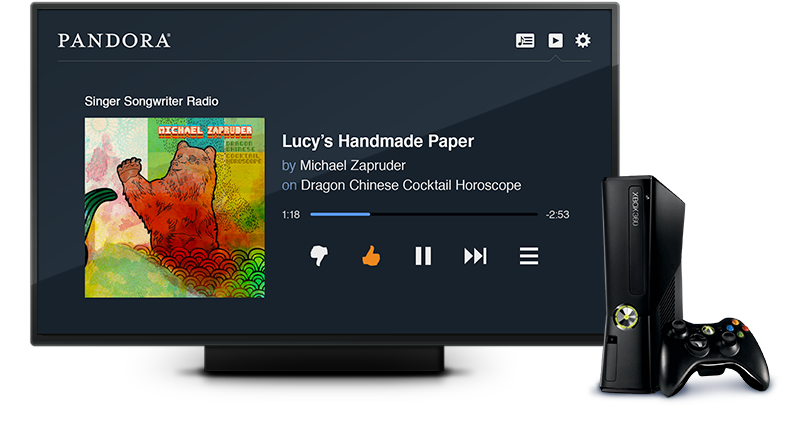Streaming music company Pandora has released a new web application for TVs, the company announced today.
The push to bring Pandora to television screens follows the company’s efforts to grow the smart radio service by making it available in Internet-connected automobiles and mobile devices. And while Pandora is available as a native app on many Smart TVs, Blu-ray players, and a handful of set-top boxes like Roku, the service has been noticeably absent from game consoles. That’s a bit odd considering that most people are connecting their televisions to the web through the Xbox 360 and the PlayStation 3. However, the new TV web app is built in HTML5, which makes it available to any TV streaming device (like those consoles) or smart TVs with web browsers.
It may seem silly for an audio-only radio service to worry about its presence on devices primarily used for video, but there are a few reasons why Pandora is interested. The first reason comes down to enhancing the user experience, according to Pandora CTO Tom Conrad.
“We know the best set of speakers in the house are in the living room,” Conrad said in an interview with VentureBeat. He added that 10 million of Pandora users have already experienced the service on TVs, and about a third of the company’s 70 million monthly active users listen to Pandora in their homes.
“What the Pandora TV [app] brings is an experience built for the remote control, and built using HTML5 standards so that that experience [stays consistent across all television screens],” he added.
Conrad explained that listeners will likely prefer the HTML5 TV app because it’s more consistent than the multitude of native Pandora apps for various brands of set-top boxes and smart TVs.
“I don’t think people are really concerned with whether they access Pandora on their TVs with a dedicated application or by clicking a bookmark for the Pandora site for TVs,” he said.
The company is also hoping device manufacturers will switch to using the HTML5 app and allow Pandora to reduce resources devoted to building and maintaining those native apps, Conrad said. In other words, Pandora wants to spend less time, money, and energy building native apps for televisions so it can presumably focus on other things. (Yet, Conrad told me that doesn’t mean Pandora won’t partner with hardware manufacturers on native apps in the future, including the possibility of native apps on Xbox and PS3.)
Another big reason the company is focusing on boosting Pandora usage on TVs? Advertising.
“It’s conceivable that we could eventually sell video advertising for the new 10-foot Pandora [TV] experience,” Conrad said. Right now the company’s biggest source of revenue comes from audio advertising, and to a lesser extent display ads on desktops, smartphones, and tablets. Pandora’s ad inventory, which doesn’t include video ads, wouldn’t initially translate to the TV screen, but there’s plenty of room for growth.
Selling video ads for its TV apps make sense for Pandora, which has been under pressure from investors to generate more revenue to compensate for what the company sees as extremely high music licensing fees. Television advertising continues to be where advertisers spend the bulk of their marketing and advertising budgets, so it’s not surprising that Pandora would want a piece of it.


